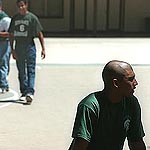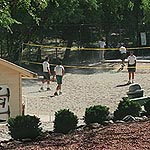The Sacramento Bee
|
Last Chance Ranch: Apology, tough line in wake of death By Sam Stanton and Mareva Brown Bee Staff Writers (Published June 28, 1998) ORACLE, Ariz. -- The head of the Arizona Boys Ranch has apologized for the death of 16-year-old Nicholaus Contreraz, and has taken responsibility for what he says were failings in the program that led to it. "We feel horrible about it," ranch President Bob Thomas said in an interview with The Bee. "We've all lost sleep. It's something I'll have to live with for the rest of my life." Although Thomas added that he has made many changes to avoid such a tragedy in the future, he acknowledged there is no way to guarantee programs such as his will not experience other deaths. "You can never ensure with this type of program that you're not going to have a death," Thomas said.
After initial public announcements that Contreraz collapsed from a heart attack, investigators discovered a more brutal truth: Contreraz died from a massive lung infection while being forced to do pushups and after being accused of faking illness. Investigators have since found that Contreraz had been sick for at least two weeks and had been vomiting and defecating on himself for several days before he died. Despite that, he was told by a camp nurse that he was fine. He also was forced to carry a bucket containing soiled clothing and vomit. "They did things to him that you just don't do to a human being," said Don Berg, Contreraz's Sacramento County probation officer. Since those revelations have surfaced, Thomas has made no effort to shift the blame away from the ranch. "It was a total management breakdown," he said. "And I'm head chef there so I'm the person who has to accept responsibility." For the Arizona Boys Ranch, the death of the Sacramento youth has proved to be the most painful chapter in its half-century history.
"It's all semantics," Thomas said. "In other words, we don't stand around and let a damn kid break windows. "And we don't sit around and let a kid hurt himself and we don't sit around and let a kid curse and let a kid jump around and hurt somebody else. We refuse to accept that kind of behavior. This is a civilized society and we expect kids to be civilized." That approach is what has built the 49-year-old program, also known as the "Last Chance Ranch," into a $26 million-a-year camp for youths who often are one step away from prison. Arizona Boys Ranch, started by the Phoenix Rotary Club in 1949 to help troubled area youngsters, now takes youths from Arizona, Illinois, Indiana and Ohio. But California is its biggest customer, providing two-thirds of the juvenile offenders at the ranch and generating $18.6 million in revenues. In Queen Creek, the ranch headquarters southeast of Phoenix, cottages, classrooms and state-of-the art athletic facilities -- including a football field and 1,000-seat gymnasium -- sprawl over 188 acres surrounded mostly by agricultural fields. Residents are taught everything from computer use to auto mechanics to raising livestock, and all of them are taught to stop and address visitors or staff members as "sir" or "ma'am." Many are quick to praise the program, saying it offers them a last chance to escape gangs, drugs and other problems they faced back home. "You have to see what kind of program it really is," Justin Cummins, a 19-year-old from Louisville, Ky., said during an interview on campus recently. "I never thought I'd have an A in my life, and now I'm getting A's and B's." Other youths have different perceptions of life on the ranch, however, particularly those who were at the Oracle orientation program where Contreraz died. Interviews by The Bee with various youths who had experienced both the Queen Creek main campus and Oracle campus revealed claims that staff members used physical force against them and sought to keep it quiet. Such comments parallel what investigators were told after Contreraz died.
Another 16-year-old told investigators such behavior stopped after the Contreraz death because of the presence of outsiders. "Well, since Mr. Contreraz is not here no more they have not been throwing people up against the door like they usually do," according to the transcripts. "I don't know. I guess they gonna wait until you all leave or something to do it again." The youths are not alone in their negative descriptions of life at the ranch.18 Steve Raths, a former English teacher at the ranch who lives in a Phoenix suburb, said in an interview with The Bee that he quit in 1991 after 1 1/2 years of regularly seeing what he believed was improper treatment, including "staff members throwing boys' bodies around for infractions I didn't think were worthy of that kind of treatment." Richard DiNaso, a 58-year-old Phoenix area man, said in an interview that he left his job as a staff supervisor last year after six months because the stress was "astronomical." "The first day I was there a young kid was snoring and I saw the staff supervisor and the senior staff member there go on over and throw him out of the bed," DiNaso said. "What are they doing? They're promoting animosity, they're not promoting respect." DiNaso said he never attended college or graduated from high school but he had little trouble landing a job at the ranch. "There was an ad in the paper," he said. "I never had any experience in this field, but when I was interviewed they asked what service I was in and I told them the Army. "They asked what branch and I said infantry. They asked what department and I said airborne, and they said, "You'll qualify.'" Thomas flatly denies that any abuse takes place, saying anyone who participated in such behavior would be fired, as several Oracle workers were after the revelations about Contreraz's death.
"They've lied before, they've cheated, they've stolen, they've done violent acts," Thomas said. "They come to Boys Ranch and they have instant credibility, more so than staff. I've always been amazed by that." To Thomas, that is the reason the Boys Ranch files at Arizona's Department of Economic Security read so negatively. One internal briefing memo from the department filed in July 1995 lists a variety of problems the agency found to be true, including a case where a youth suffered a bloodied or broken nose after his face was slammed into a table; another where a boy was restrained so roughly that his left eyebrow needed four stitches; and another where a boy's blistered feet were scalded in a tub of hot water and later required skin grafts. Thomas said the reports aren't necessarily true. He said investigators substantiated an allegation if more than half the juveniles and staff members questioned agreed with the allegations. "As long as they believe 51 percent is true, it's "substantiated abuse,'" Thomas said, "and I say that's unconscionable." The battle over such regulation reached a high point in 1994, when the Arizona Boys Ranch sued the state over what it saw as overzealous regulation. That year marked a nadir for Boys Ranch. The program suffered its only other fatality -- the death of 17-year-old Lorenzo Johnson, who died after running away from the Queen Creek campus and drowning in an irrigation canal -- and Alameda County pulled its 57 youths from the program after a trio of escapees claimed they were abused by staff members, records in Arizona show. Beset by allegations, Thomas eventually turned to a respected Arizona legal expert -- former U.S. Attorney A. Melvin McDonald -- and hired him to perform an audit of the ranch. The study cost Thomas $400,000 but was done without any attmept by the ranch to influence its findings, he says. It alleges that Arizona Child Protective Services and licensing investigators were incompetent and disputed virtually all of the 13 abuse allegations the state had said were true. Two other studies performed in recent years -- both funded by the ranch at about $10,000 each -- have been similarly laudatory. A separate study performed by University of Illinois Professor Ron Davidson, which was not funded by the ranch, was highly critical and found "a compelling body of critical evidence to suggest that the Arizona Boys Ranch has long encouraged or tolerated a de facto policy of abusive conduct on the part of its staff." Thomas has denounced that study as the product of a three-hour visit by Davidson during which he interviewed one youth. He claims the professor based much of the rest of the review on negative stories that were appearing at the time in the Arizona Republic, the state's largest newspaper, which was probing the program in the wake of the Lorenzo Johnson drowning. Eventually, the ranch sued Davidson to stop distribution of the report, according to Thomas. The lawsuit ultimately was dropped. Boys Ranch also has sued the Republic, a case which is expected to go to trial late this fall. Davidson said he hs been prohibited about talking about the study because of the lawsuit. The ranch remains one of the more powerful entities in Arizona, and its board of directors and advisory board include some well-known figures inside and outside of Arizona. They include GOP political strategist George Gorton, a longtime adviser to California Gov. Pete Wilson, and former Arizona Gov. Rose Mofford. Mofford said she was saddened by the Contreraz death but that she is perplexed by the breadth of the controversy that has engulfed the ranch. "I'm very proud of the progress there and the board seems to be quite supportive," Mofford said. "It really is an outstanding organization." Even Berg, Contreraz's probation officer in Sacramento, agrees that the ranch's overall concept is useful.
"Philosophically, we disagree with some of their methods. But it works." Since Contreraz died, however, many are questioning the concept espoused by Thomas, and the ranch faces several investigations that threaten its very existence. Arizona officials from two separate agencies are about to complete a probe of the Contreraz death and 23 other allegations of abuse that surfaced after the death. Arizona also must decide whether to renew the ranch's license to operate, which expires on Tuesday. And prosecutors in Pinal County, where the now-closed Camp Mary Mullaney is located, still are debating whether to file criminal charges against any of the ranch employees involved with Contreraz in his last days. Thomas said he expects the ranch to be re-licensed and that he hopes to reopen the Oracle camp in six to eight months, a delay caused by the difficulty of finding adequate medical supervision for such a remote location. He also said that if California decides to permanently stop using the ranch, the state will be hurting its own citizens more than his operation.
"If they think they're going to pull 1,000 kids back and put them in group homes, I feel sorry for the communities," he said. "And I feel especially sorry for the kids."
|
| ||||||||||||||
Copyright © The Sacramento Bee | |||||||||||||||





 Who's guarding the kids?
Who's guarding the kids?

